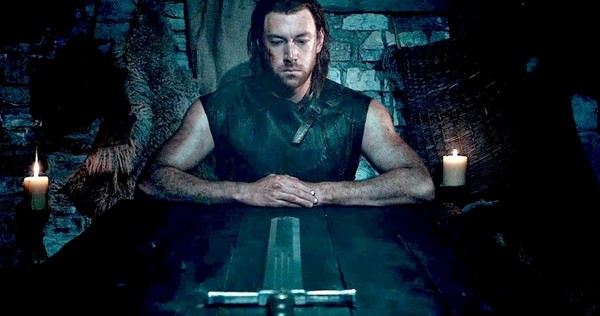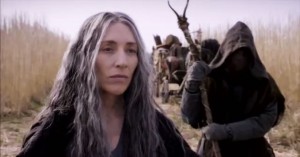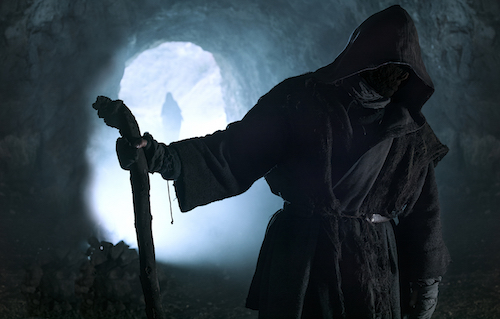We live in an age of genre television. The seeds planted in primetime TV years ago by The X-Files and LOST have bloomed, and the once-safe block of medical procedurals or four-camera sitcoms is increasingly crowded out by wizards or zombies or at the very least, bad boy hackers. Since Game of Thrones is maybe the biggest TV series in the world right now and audiences are primed for high fantasy and incredible violence, it’s maybe not surprising that The Bastard Exectutioner, a historical drama/fantasy, is one of FX’s big fall shows. It’s also not very surprising that The Bastard Executioner, the latest project from Sons of Anarchy creator Kurt Sutter, is pretty much godawful.
The Bastard Executioner is set in feudal Wales, where Wilkin Brattle (Lee Jones), a former knight of England, lives a peaceful life of semi-anonymity. Brattle was a skilled, feared knight who had been sent on a suicide mission by…some guys who disliked him, but who found peace in leaving his army behind and becoming a rural farmer. He lives happily in a small town with his pregnant wife (Elen Rhys) and his countrymen. However, Wilkin and his neighbors have been carrying out rebel strikes against the local baron and his chamberlain, Milus (Stephen Moyer), which eventually leads the baron’s men to brutally slaughter the women, children, and anyone else who happened to be in the village at the time. Seriously, really brutal stuff. Babies cut out of wombs, etc. Even Thrones didn’t open this graphically.
Anyway, Brattle and his fellow rebels come back and swear vengeance, and they even manage to confront and kill the Baron and a number of his men on the way back to his castle. Brattle is all set to die a glorious Braveheart death while fighting his way into the castle, until a Slavic witch (Katey Sagal, of COURSE) comes up with another option: He can impersonate the recently hired and even more recently deceased executioner, and slowly plot his revenge under everyone’s nose. This is roughly two hours into the show when we’re finally reaching the actual premise and status quo.
Part of the reason I waited a few weeks to review the show was because the premiere was so sprawling and overblown. “Maybe once we settle down, there’s actually something good here,” I thought. “Maybe all this dumb stuff is in service of a surprisingly good show.” Two episodes later, and I’ve been proven wrong again. The average episode of The Bastard Executioner involves Brattle torn between his hatred of violence and his job of violence, and it’s mostly boring and occasionally grotesque. No one is putting in a memorable performance, and even the points where there could be the spark of a good story (the deceased executioner’s wife vouches for Brattle’s identity, her motives unclear) end up petering out (turns out she’s just crazy!). It’s all gloomy and plodding, and the few stabs at humor the show makes rely on some idiot farmer who has sex with his sheep.
The show is generally just a mess. Characters speak in a hard to follow murmur, and most of them are lumpy bearded white guys so it’s anyone’s guess who’s who. It’s confusing in the way people sometimes claim Game of Thrones is, but without any visual flair or compositional insight. Brattle slaughters men in hayfields as mournful electric guitars play, but none of it feels like it means anything. The story is based on actual historical struggles in England, but it feels far less relatable than most shows on TV, including those set in outer space or on made-up planets.
Really, the most useful purpose of The Bastard Executioner is as an object lesson in how much stuff Game of Thrones does well, and what it looks like when that stuff goes wrong. In Game of Thrones, characters have distinct color palettes and styles for their costume design that communicate everything from their personalities to who they’re allied with. In The Bastard Executioner, most people wear brown, even nobles, and the very best outfits look like loaners from a local theater guild. In Game of Thrones, when a new character who will be important is introduced, they’re given a lot of screentime and characters address them by name repeatedly. In The Bastard Executioner, when a new character is introduced, it’s generally unclear if they’re someone you’ve seen before, a one-scene extra, or a new lead. It reaches the point where I don’t even know who the show is for. It’s generally boring and pretty slavishly devoted to minute details of the Middle Ages, so I doubt Sons of Anarchy fans are going to flock to it. It’s amateurish and shallow, so more discerning primetime viewers will probably skip it. Maybe it’s a good show to leave on during a weekend trip to keep your dog company? I dunno.
There are a couple points I do want to praise. One, and I mean this sincerely, is that it’s cool to see actors of color in a historical fiction setting. The Bastard Executioner has had several, and it’s the one aspect of the show that any other medieval shows should emulate. The other is that Katey Sagal’s strange B-movie caricature witch has a sidekick, a hooded, scarred-up henchman with whom she has sex for mysterious, presumably witchcraft-related reasons. This henchman is played by none other than Kurt Sutter himself. That’s right, Sutter got FX to pay him to have TV sex with his real-life wife in a cave wearing heavy makeup. That’s a decision so shameless, so audacious, that I have to give him props for going with it. Godspeed, Kurt Sutter, you weird freak.
There are shows I watch that revel in their lack of seriousness, like Gotham. There are shows I watch that can’t decide how seriously to take themselves and suffer for it, like The Strain. And then there’s The Bastard Executioner, a show that takes itself entirely too seriously when it’s one guy in a jester suit short of a farce. It airs Tuesday nights at 10 on FX, if you want to see what it’s like to actually be relieved and excited when a show cuts to commercials.



